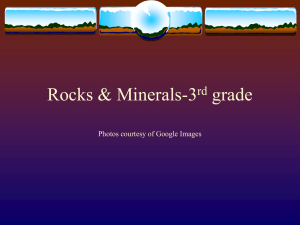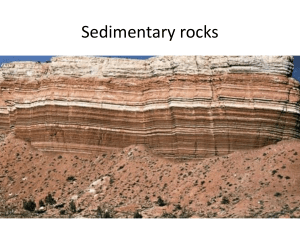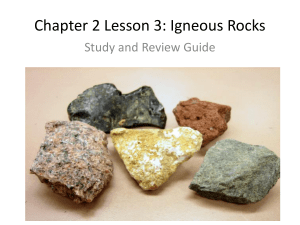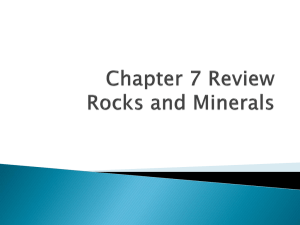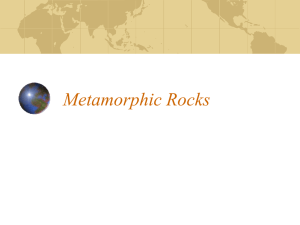3 types of rocks powerpoint (Slides 1-8)
advertisement
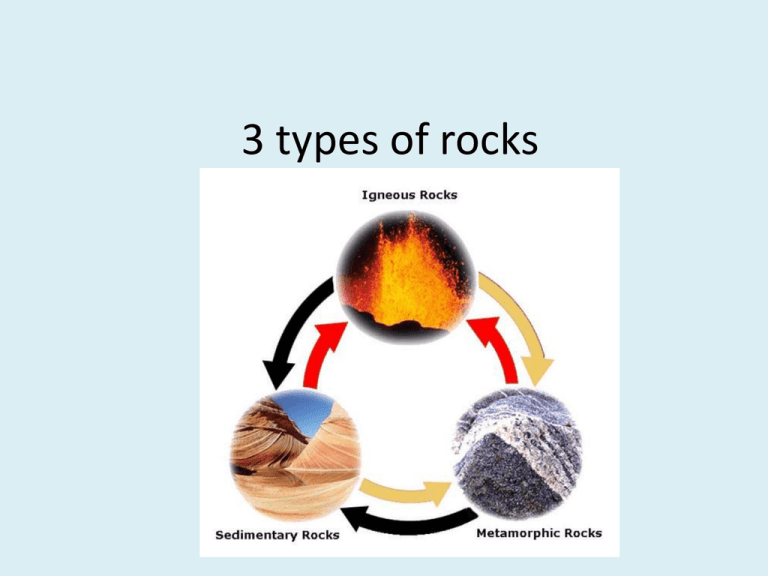
3 types of rocks 3 types of rocks • There are 3 types of rocks found on Earth: – Igneous – Sedimentary – Metamorphic • Knowing the differences between these 3 types of rocks allows us to learn about Earth’s past. Igneous Rocks - Formation • Igneous Rocks are formed by melting, cooling, and crystallization of other rocks. • Igneous rocks form as a result of volcanic activity, hot spots, and melting that occurs in the mantle. Igneous rocks • Igneous rocks are common along plate boundaries or mantle hot spots Igneous Rocks - Classification • Igneous rocks are classified using their texture in the following ways: – – – – Glassy Aphanitic (no visible crystals) Phaneritic (visible crystals) Porphyritic (Some visible and some not visible crystals) Igneous Rocks - Texture • Crystal size is used to classify igneous rocks. • Crystals form as the rock cools, and the crystal size can tell us a lot about its cooling history: – The larger the crystals, the slower it cooled. Igneous Rocks - Texture • Glassy igneous rocks have no crystal structure, and probably formed by very rapid cooling (such as on the surface of a lava, or when a lava enters the water.) Igneous Rocks - Texture • Aphanitic rocks have no visible crystals, and probably formed by fast cooling above ground. Igneous Rocks - Texture • Phaneritic rocks have visible crystals, and probably formed by slow cooling below ground. Igneous Rocks - Texture • Porphyritic rocks have both visible and nonvisible crystals, and probably formed by two different cooling events. Igneous Rocks - Classification • Dark igneous rocks are formed from basaltic or mafic magma. (Mafic because it contains a lot of magnesium and iron). • The magma that forms these rocks is usually very hot (around 1000°C) and viscous (about the same viscosity as ketchup.) Igneous Rocks - Classification • Light colored igneous rocks are formed from silicic (high silica content) or felsic magmas. • The magmas that form these rocks is usually more cool, (lower than 850°C), and more viscous (about the viscosity of peanut butter.) Igneous rocks - Formations • Structures and formations seen in igneous rocks include: – Hexagonal columnar joints – Pahoehoe lava flows – Dikes, sills, and batholiths (plutons) – Pillow basalts – Volcanoes Igneous Rocks - Examples • The most common types of igneous rocks include: – – – – – – Rhyolite Andesite Basalt Granite Diorite Gabbro Igneous rocks charted Igneous rocks - Story • What do you know about the history of the Earth in the place where this rock was found? Sedimentary Rocks - Formation • Sedimentary rocks are formed by weathering, erosion, deposition, compaction, and cementation of other rocks. • Sedimentary rocks form in areas where water, wind, or gravity deposit sediments. Sedimentary rocks - formation • Sedimentary rocks are likely to form in areas such as: – – – – – – – Deltas Beaches Rivers Glaciers Sand dunes Shallow seas Deep oceans Sedimentary rocks - Classification • Sedimentary rocks are classified into two groups: – Clastic rocks – Chemically formed rocks Sedimentary rocks – Classification • Sedimentary rocks are Clastic if they are made of pieces of other rocks that have been weathered and eroded. • Clastic rocks are grouped based on the size of grain that they are made from. Sedimentary rocks - Classification • Very small particles make up mudrock. • Medium sized particles make up sandstone. • Large particles make up conglomerates. Sedimentary rocks - Classification • Sedimentary rocks that form from chemical processes are called biochemical rocks (formed from living things) or Chemical precipitates (formed from lakes or shallow seas.) Sedimentary rocks - formations • Structures and formations seen in sedimentary rocks include: – – – – – – Stratification Cross bedding Graded bedding Ripple marks Mud cracks Fossils Sedimentary rocks - Examples • Some of the most common types of sedimentary rocks include: – – – – – – – Conglomerate Sandstone Shale Limestone Gypsum Oolites Chert (including black flint and red jasper) Sedimentary rocks - Story • What do you know about the history of the Earth in the place where this rock was found? Metamorphic rocks - Formation • Metamorphic rocks are formed by heat and pressure changing one type of rock into another type of rock. • Metamorphic rocks form near lava intrusions, at plate subduction zones, and in deep mountain roots. Metamorphic rocks - Formation • Lava intrusions can provide heat that causes metamorphic rocks to form. These small areas of metamorphic rock form from contact metamorphosis. Metamorphic rocks - Formation • Rocks that metamorphose because of increasing heat and pressure found at plate subduction zones and in deep mountain roots form large areas of metamorphic rock through regional metamorphosis. Metamorphic rocks - Classification • Metamorphic rocks are classified into 2 major groups: – Foliated – Nonfoliated Metamorphic rocks - Classification • Foliated rocks form when differential pressure causes minerals to form in layers. • These rocks will have stripes or planes that they will break easily along. • These “stripes” don’t usually line up with the original bedding planes in sedimentary rocks. Metamorphic rocks • Nonfoliated metamorphic rocks formed in areas where the pressure from all sides was equal, so there is no “linear” quality to the rocks. Metamorphic rocks - Formations • Structures and formations seen in metamorphic rocks include: – – – – Folding Plastic deformation Stretching Alternating dark and light layers (gneissic foliation) Metamorphic rocks - Examples • Some common types of metamorphic rock include: – – – – – – – Slate Schist Gneiss Amphibolite Marble Quartzite Metaconglomerate Metamorphic rocks - Charted Metamorphic rocks - story • What do you know about the history of the Earth in the place where this rock was found?

